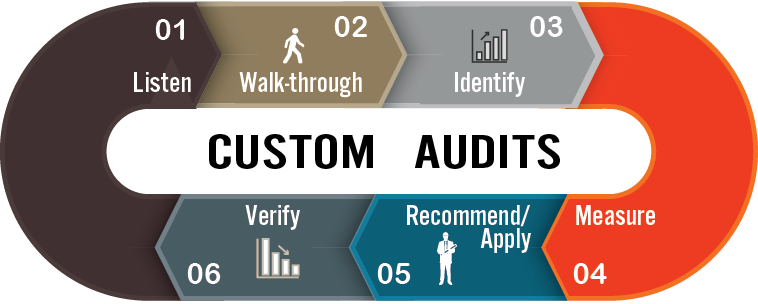




 Energy Audit
Energy Audit
Energy Audit Services in India-Sachu Technologies
Sachu Technologies offering Energy Auditing proposes a comprehensive power quality, Thermography along with other required instruments & safety audit for power optimization
 |
Key Objectives of Energy Auditing:
An energy audit consists steps that can be performed office and at the organization’s facilities
Data collection:
the auditor starts collecting some preliminary information on the energy consumption of the facilities and some technical details such as process diagrams, drawings and equipment inventory - usually provided by the organization.
Field work: at least one on-site visit is required, with the aim of gathering all the information needed for the study depending on the defined scope. This information includes collecting details of the energy consuming equipment such as brand, model, power and hours of operation. Some interviews with staff will also be required. Depending on the type of energy audit, some metering devices will be used.
Analysis of energy consumption and performance of energy accounting: all the operations of the organization must be analyzed, as well as the equipment consuming higher energy.The processes which have higher energy consumption must be identified in order to determine the potential for reducing it and to define the energy saving measures to improve global energy performance.All information collected is used to evaluate the different uses of energy within the process and to establish a breakdown of the energy consumed. This energy accounting is also called Energy Balance.
Analysis and development of energy saving measures: :once all the data collected has been analyzed, energy saving measures can be identified. The information collected and analyzed enables the auditor to detect energy saving measures to reduce energy consumption. Energy and cost savings of these measures will be assessed, together with investment needed and payback.
Energy audit report: following the energy audit, an energy audit report must be issued, which should include at least the following information:
Technical scope: this point includes facilities, services and included areas and level of depth in the analysis and detail required.
Methodology: this point includes the analysis of the state of art of the facilities (energy inputs, technologies and services), measurement results and energy balance.
Suggested energy saving measures: this point includes a description of each energy saving measure, including potential energy savings, economic savings, investment needed and payback.
Conclusions: this point includes the recommended measures, total energy savings, total economic savings, total investment and payback.